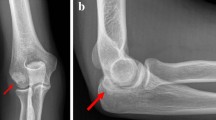Abstract
Background
The aim of this study was the prevalence of patella cubiti and os supratrochleare dorsale, and to detect the differences between genders.
Materials and Methods
In the study, direct radiographs of 1646 people (959 females and 687 males), who presented to Fırat University Hospital between 01.01.2016 and 31.01.2019 and had elbow joint radiographs, were evaluated retrospectively. Of the radiographs evaluated, 346 were right and left elbow radiographs of the same people, 689 were just right elbow radiographs, and 611 were only left elbow radiographs.
Results
The prevalence of os supratrochleare dorsale was 2.08% (20 in 959 women) in women, 2.62% (18 in 687 men) in men, and 2.3% (38 in 1646 people) in total. The prevalence of patella cubiti was found to be 0.42% (4 in 959 women) in women, 1.31% (9 in 687 men) in men, and 0.79% (13 in 1646 people) in total. In addition, the prevalence of both sesamoid bones only in the left elbow and in both elbows was determined with and without separation according to male–female genders.
Conclusion
We are of the opinion that knowing the prevalence and distribution of these sesamoid bones will help with establishing early and correct diagnoses for patients who present with complaints, such as elbow extension limitation and pain in the elbow area.


Similar content being viewed by others
References
Mellado, J. M., Ramos, A., Salvado, E., et al. (2003). Accessory ossicles and sesamoid bones of the ankle and foot: Imaging findings, clinical significance and differential diagnosis. European Radiology, 13, L164–L177. https://doi.org/10.1007/s00330-003-2011-8
Dąbrowski, K., Stankiewicz-Jóźwicka, H., Kowalczyk, A., et al. (2019). Ossa Sesamoidea—prevalence of sesamoid bones in human hands. Folia Morphologica (Warsz). https://doi.org/10.5603/FM.a2019.0123
Dąbrowski, K. P., Stankiewicz-Jóźwicka, H., Kowalczyk, A., et al. (2020). Morphology of sesamoid bones in keyboard musicians. Folia Morphologica (Warsz). https://doi.org/10.5603/FM.a2020.0066
Nwawka, O. K., Hayashi, D., Diaz, L. E., et al. (2013). Sesamoids and accessory ossicles of the foot: Anatomical variability and related pathology. Insights Into Imaging, 4, 581–593. https://doi.org/10.1007/s13244-013-0277-1
Müller, D., & Schäffeler, C. (2018). Normvarianten und Pitfalls rund um den Ellenbogen [Normal variants and pitfalls at the elbow joint]. Der Radiologe, 58, 1011–1020. https://doi.org/10.1007/s00117-018-0457-6
Mittal, R., Sampath Kumar, V., & Gupta, T. (2014). Patella cubiti: A case report and literature review. Archives of Orthopaedic and Trauma Surgery, 134, 467–471. https://doi.org/10.1007/s00402-014-1926-7
Obermann, W. R., & Loose, H. W. (1983). The os supratrochleare dorsale: A normal variant that may cause symptoms. AJR: The American Journal of Roentgenology, 141, 123–127. https://doi.org/10.2214/ajr.141.1.123
Morton, H. S., & Crysler, W. E. (1945). Osteochondritis dissecans of the supratrochlear septum. The Journal of Bone and Joint Surgery, 27, 12–24.
Afshar, A. (2011). Os supratrochleare dorsale. The Journal of Hand Surgery, 36, 821–822. https://doi.org/10.1177/1753193411419948
Author information
Authors and Affiliations
Corresponding author
Ethics declarations
Conflict of Interest
The authors declare that they have no conflicts of interest.
Ethical Standard Statement
This study was approved by Firat University Non-Interventional Research Ethics Committee with the decision dated 29.04.2020 and numbered 2020/07-16.
Informed Consent
For this type of study, informed consent is not required.
Additional information
Publisher's Note
Springer Nature remains neutral with regard to jurisdictional claims in published maps and institutional affiliations.
Rights and permissions
About this article
Cite this article
Aksu, F., Akkoc, R.F. & Aydin, S. Could the Prevalence and Distribution of Os Supratrochleare Dorsale and Patella Cubiti be the Key to Accurate Diagnosis?. JOIO 56, 883–886 (2022). https://doi.org/10.1007/s43465-022-00600-z
Received:
Accepted:
Published:
Issue Date:
DOI: https://doi.org/10.1007/s43465-022-00600-z




